Back in 1985 Porsche went into battle – against itself. The 944 Turbo and the 911 Carrera 3.2 were priced within £100 of each other and boasted near identical performance, yet to drive, each couldn’t be more different. Nearly 40-years on, we recreate the famous Car magazine road test, which pitched the two head-to-head. Will the verdict stand?
“The verdict? There are many good reasons for buying a Carrera. The timeless shape, the powerful six-cylinder boxer engine, the way it is put together, the urge to demonstrate that you have mastered the monster, the obvious prestige value. It’s tempting. And yet, for effortless driving pleasure and near perfect roadability, take the 944 Turbo. It is the better car.”
So read the verdict from Car magazine’s memorable test of the then-new Porsche 944 Turbo against the Carrera 3.2 from its March 1985 issue – the writer, one George Kacher, a motoring journalist of such long-standing in Germany, that he has become something of a household name in a nation that is obsessed with the automobile and the health of its home-grown automotive industry.
It’s a verdict with a number of caveats. Even back in 1985, the 911 was a sports car with a near mythical status, revered by its owners, fans and motoring journos. It was also 22 years old (albeit with 22 years of development) and quirky and cranky in equal measure, which is perhaps why Porsche thought it could launch another 2+2 sports car, with near identical performance and a near identical price (£25,312, within £100 of the Carrera 3.2). They reasoned that the two cars would attract different buyers. Good old Car blew that one out of the water. In the days before in your face cover lines, Car simply put the two cars on the cover (in snow) with the words: “Porsche’s 153mph 944 Turbo battles its deadliest rival.” Well, back then Car was the de facto number one motoring comic and didn’t need to work too hard to shift 150,000+ issues a month!
In the cold light of day, it was hard to argue with Kacher’s verdict. Taken in the context of 1985, when the 911 was getting on a bit, and really not that much different from its last major makeover in 1974, the 944 was a much more contemporary machine, for rather more modern times. True, it was developed from the 924 – the shunned love child developed at the behest of VW, but thrown back at Porsche – but it was 95% Porsche by the time the 944 Turbo was boosted on to the market.
If you were a Porsche virgin in the mid ’80s, but no stranger to performance cars of the era and you were in the market for a 220bhp-230bhp, £25,312–£25,412 sports car, with a Porsche badge on the bonnet, then you could be forgiven for being somewhat perplexed after a test drive of these two. The 911’s quirks grow on you, but on first acquaintance seem positively weird. Think floor sprouting, offset pedals, that require your foot to be lifted entirely from the foot well to work the brake and clutch, an obstructive 915 gearbox, unfathomable ventilation and frankly odd handling. In the 911 you work hard, and put up with a lot for your reward, which only comes with experience.
On the flipside the 944 Turbo is, well, normal. That is to say normal in the sense of its basic functions. Normal seating position, normal pedal location, a gearshift that flicks though the gate in a, er, normal sort of way. Sounds like we’re damning with faint praise here. We’re not. It’s just to say that compared to a 911, just about every car in 1985 could be considered ‘normal.’ Largely because they couldn’t trace their ancestry back to a kind of VW kit car, which started off as being mid-engined, and then became rear-engined to allow a 2+2 configuration. Simplistic, perhaps, but true.
What wasn’t so ‘normal’ about the 944 Turbo was, and is, its dynamics. It had one of the first really effective turbo installations that drew on all of Porsche’s turbocharging experience, from racing and the 911 Turbo. It had handling that was – thanks to its front engine/rear transaxle layout – inspirational. Combine this with the aforementioned functionality, and you had a sports car with huge but accessible performance. For 1980s man, what’s not to like? Oh, and it had a turbo, which in the ’80s was a word that really meant something, even when applied to a vacuum cleaner.
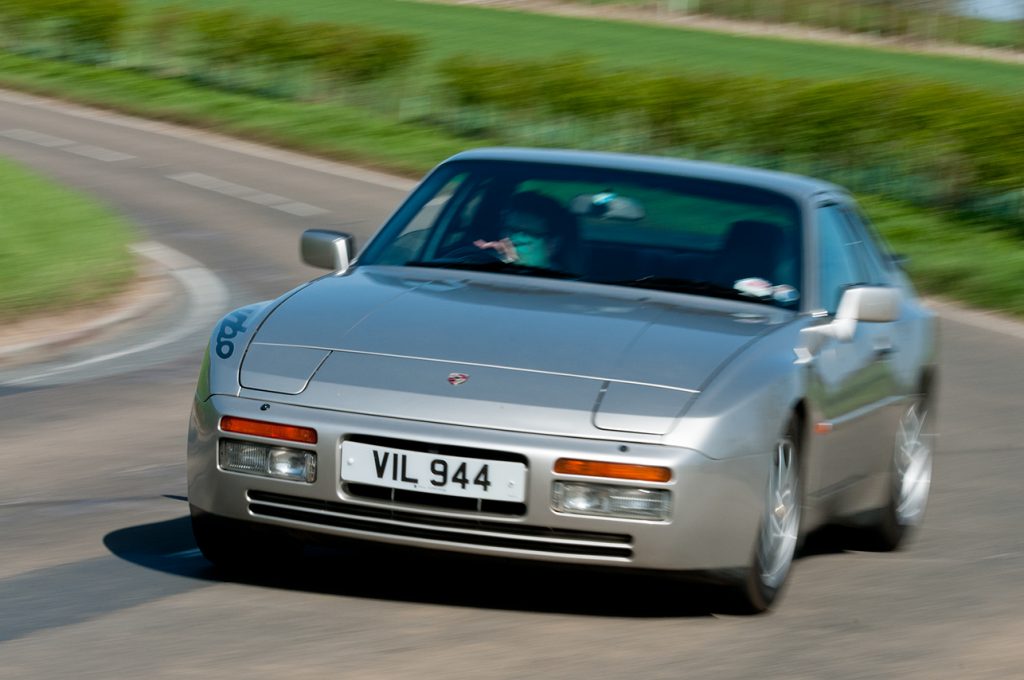
In 1985, most 911s and 944 Turbos were bought to be used as everyday transport. Most of the contemporary road tests reflected that. Kacher and Car mag’s test certainly did. Today the motivation for buying either car is very, very different.
Wind the boost forward to 2024 and one man’s main course from 1985 is now very much a light snack to be indulged in, when the mood takes. Both the modernist 944 Turbo and the already classic 911 are now in the same floating vessel. The cold, hard-edged analysis of the day-to-day no longer counts. 944 Turbo v 911 is now an emotional and aesthetic choice. It’s how they make you feel. In which case, the choice is rather more clear-cut, surely? Well, the market certainly thinks so, separating good 944 Turbos and Carrera 3.2s by up to and often well over, £20,000.
How do the two protagonists stack up 35 years on? Well here at Paul Stephens, we thought we’d find out, not least because we had both in the showroom. We’ve moved the game on slightly to pitch a 1988 944 Turbo S against a 1989 Carrera 3.2. That works in both cars’ favour, since the Turbo benefits from 250bhp over the launch car’s 220bhp, a limited slip diff, plus bigger brakes and the MO30 suspension kit with Koni dampers and stiffer anti roll bars. The Carrera is one of the last of the G-Series cars and benefits accordingly from every tweak and incremental improvement, most notably the 1987 move to the G50 gearbox.
Whoever specced these two cars back in the day showed impeccable taste. The Turbo S is special order in Zermatt Silver, with a black leather interior. The Carrera is equally silver with a blue leather interior. Both combos make our pairing look far more contemporary than the usual red, white or black of the ’80s era.
944 Turbo
Time to go for a drive. Being a serial 944 owner I jump in the 944 Turbo first (I also had a Carrera 3.2 for many years, so no bias), it’s a very familiar place and this car is blessed with deep bolstered ‘Sports’ option seats, easily the most comfortable and supportive seat that Porsche has ever produced. It’s a good start. Typically, the Turbo churns into life. You can almost feel the strain that it takes to turn over the four big pistons. The KKK turbo acts as a suppressant, calming and quietening the engine. Air-cooled it is not.
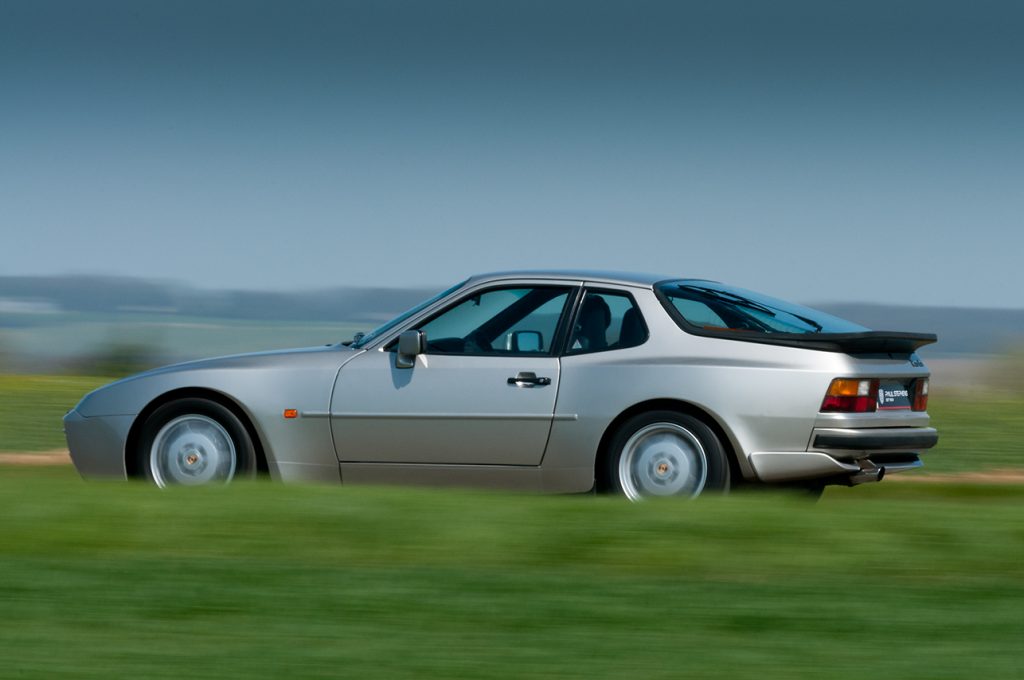
You can tell a ropey 944 almost immediately. The big four-cylinder engine and rear transaxle are joined by a propshaft ‘torque tube’, and any wear in the engine mounts, torque tube bearings, gearbox mounts or transaxle will immediately be felt through the bodyshell. It’s a series of solutions that Porsche devised to make the 944 as smooth as possible, and far more complex than the 911’s drivetrain. Most critical are the fluid-filled engine mounts (always fit O/E – anything else will be solid rubber), designed to smooth out – along with the counter-rotating balance shafts – the big four pot’s inherent lumpy vibes.
When 944s fall into decrepitude, this is the sort of maintenance that is ignored. But not so this example. There is no bad-vibing from the drivetrain and the suspension is taught and clonk free. It is, in short, a healthy specimen, with 117,000 miles on the clock or a mere 4333 miles a year, depending on which way you want to look at it.

To drive the 944 Turbo feels perfectly modern, save for a higher degree of weighting in the controls. The steering is assisted, but still has plenty of resistance and a distinct damping effect at dead centre. There is a linear feel to the clutch and a weight to the floor-mounted throttle. The gearlever is stubby, but long and pronounced in its throw. It all feels engineered and cohesive.
It’s turbo fast. Boost is laggy by today’s standards, but by mid ’80s’ standards it’s pretty responsive, blending in smoothly from 2000rpm and peaking strongly around 6000rpm. Torque is rated at 258lb ft at 4000rpm, which compares with the Carrera 3.2’s 209lb ft at 4800rpm. That sort of muscle makes itself felt and the 944 Turbo does genuinely surge with a thrilling dollop of boost pressure.
And the famed handling? It’s sublime. The suspension – stiff by mid-’80s standards – is compliant for today’s pock-marked roads and the balance is all there thanks to that 50/50 layout. It is the very antithesis of the pendulum like 911, but not so benign as to be boringly neutral. Instead it flows along the road, settling into corners and powering out with a squat from the rear. The turbo makes it slightly unpredictable to throttle inputs at times (in a way that a 944S2, for example, doesn’t), but overall chassis and power are a good match.
Carrera 3.2
And so, to the arch rival from within and a car that really can wear the badge of ‘icon’ with confidence. Game over then?
No, not at all. They make for a compelling counterpoint underpinned by their contemporary rivalry. The 944 burnt brightly in the ’80s, it was of its time, while the 911 has proved to be enduringly unshakeable. It doesn’t mean that it’s the better car though.
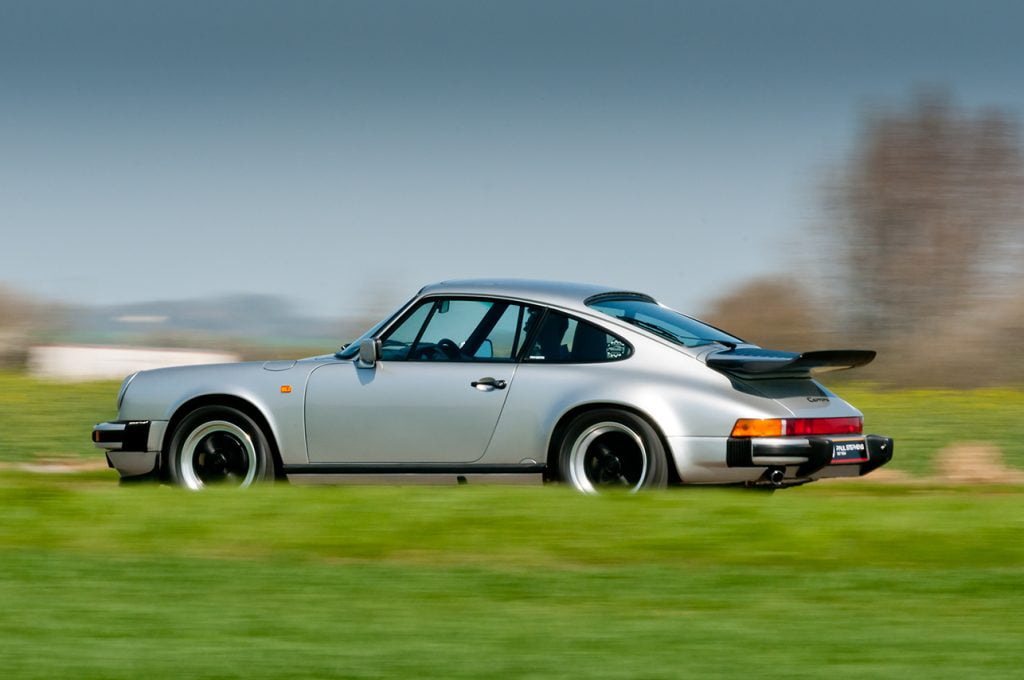
There’s no getting away from the frisson of excitement on entering a 911. Like the 944, it has the excellent, snugly ‘Sports’ option seats and the four-spoke ‘lozenge’ steering wheel, but beyond that it’s a different environment and ambience, tight fitting and narrow to the point that, with a passenger on board, you virtually rub shoulders.
No getting away, either, from the frisson of excitement from starting the Carrera up. Sportscar manufacturers go to all sorts of lengths these days to engineer in that sense of start-up occasion. All you need with an air-cooled 911 is a key. The rest it does for itself with a cranking, churning whine and clattering ignition underpinned by that offbeat, air-cooled thrum. There’s no shame on the 944 Turbo for not being able to compete sonically, because frankly there are not many cars that can. Noise dominates the Carrera 3.2. It is its very beguiling essence.
Driving it is an old school, immersive, interactive experience. It doesn’t do anything for you, although with this late G50 equipped version, it does at least lend a hand with changing gear. The offset pedals (left hookers are better) require a special sort of dance to operate them, while the engine responds to the long throw throttle pedal with a deep surge that starts low and peaks at a rushing, clattering, hard-edged 5900rpm, blunted slightly by the Carrera’s heavy but smoothing flywheel.
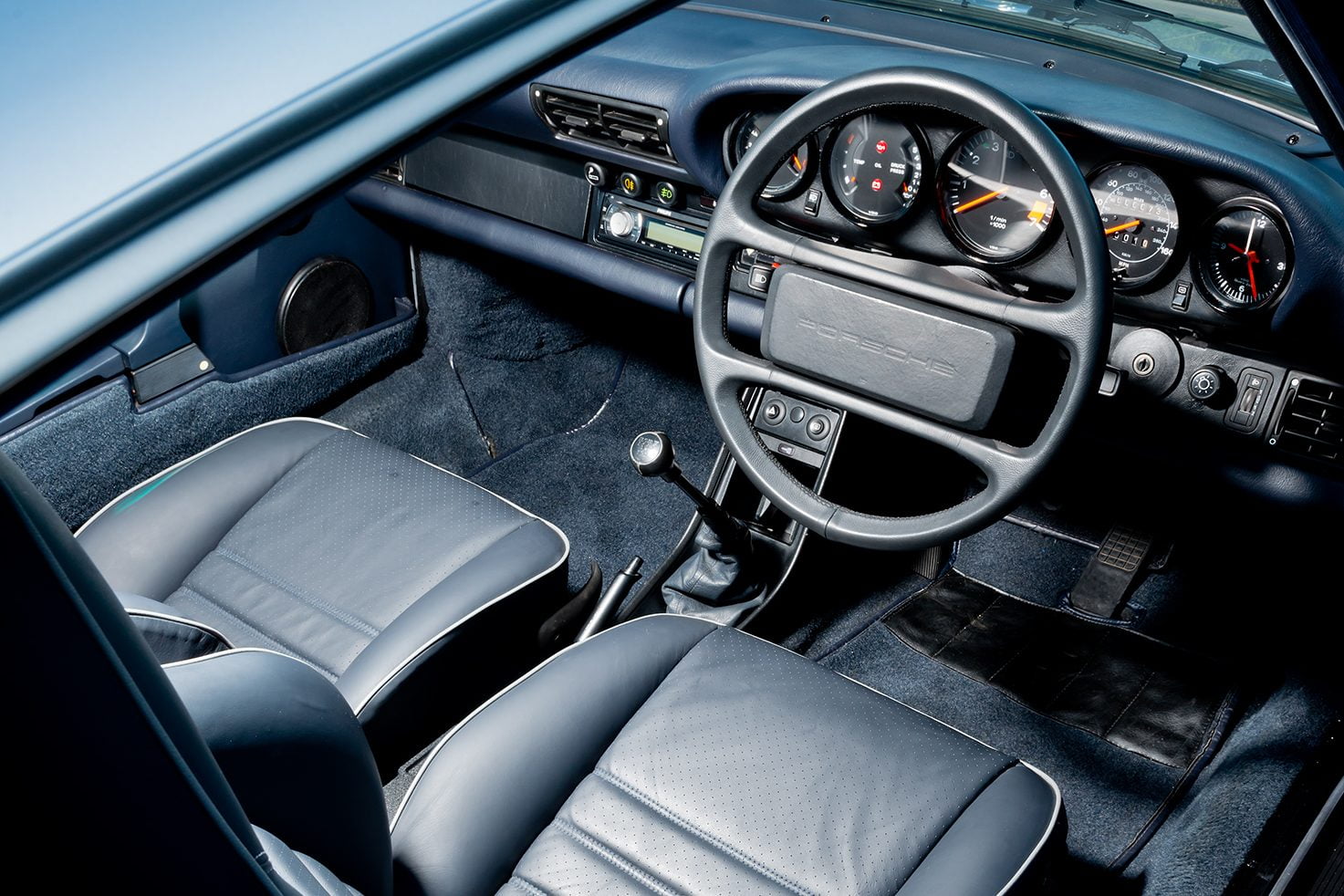
Punt it into a corner and you need to be prepared to work. There’s no power steering and with all that weight at the rear, and those big rear tyres, it doesn’t really want to know. The steering is slow-geared too, one of a raft of measures to stop the 911 from overtaking itself as weight transfer takes over from enthusiasm. It needs to be worked and bullied into a corner and once in, held there or understeer will prevail. There is, though, immense chatter and feedback though the wheel and that lovely squatting surge when the corner opens out and you can put the hammer down.
And you can use that rear engine weight to help you along. A slight lift here, an adjustment to the throttle there, and the back end can be used to assist the front. It’s part of the 911’s unique charm, and one that racers love because it gives them options. For mere mortals, though, it can be the hand that bites, rather than feeds. Put it this way, in a straight fight most mere mortals wouldn’t see which way the 944 Turbo went because it is simply the easier car to drive, devoid of the 911’s quirky machismo. The 911 is a workout on wheels and on this early spring day my shirt is soaked with sweat, not helped by the 911’s – typical of the era – lack of air-conditioning.
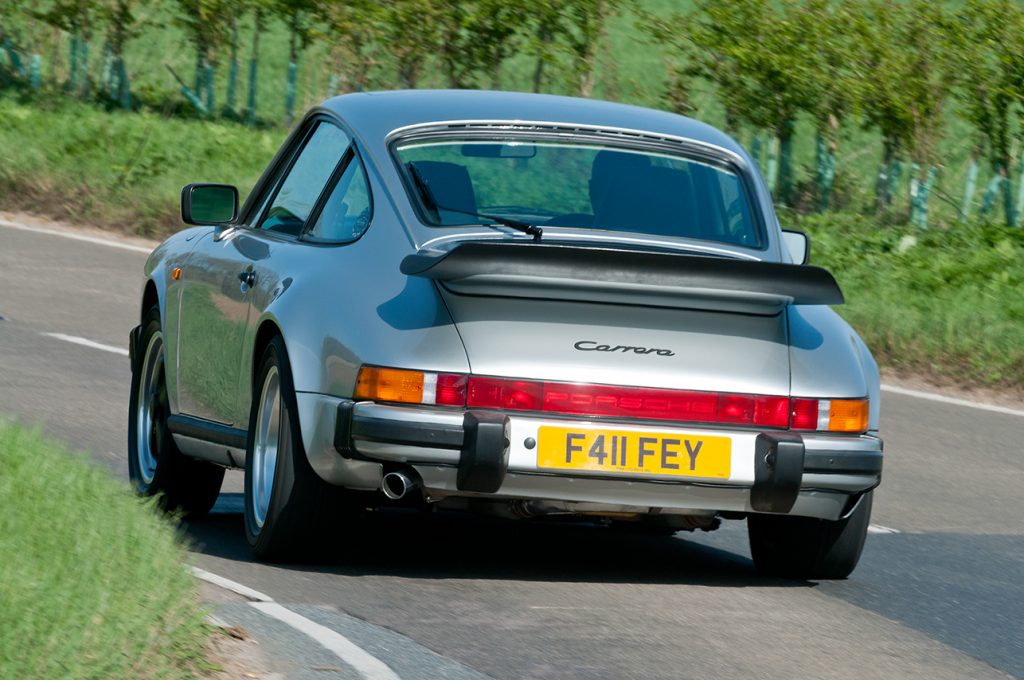

Both cars were acquired and sold by Paul Stephens.
So, let’s go back again to that verdict. At the time Kacher and Car had it right. “Effortless driving pleasure, perfect roadability, the better car.” All those statements are true in the context of the time and era and they are true now. Drive each for 150 fast miles and in the 911 you will have had a workout and in the 944 Turbo ready to do it all over again. And yet? And yet the 911 has endured, prospered and flourished for all its inappropriate vices and seen off all rivals, even those from within. It is the perfect car for a short, sharp blast and a bit of a tussle. It rewards in a way that the 944 Turbo doesn’t quite. The 944 Turbo doesn’t quite have the charisma, is a little bit more ordinary, but I suspect that for any person who had the use of both on a full-time basis, back in the day, it would be the 944 Turbo that came out on top as the weapon of choice.
And now? With Carrera 3.2 prices at the top-end, the choice for many will make itself. Good 944 Turbos are where good Carrera 3.2s were before the market went bonkers. Their respective abilities do not equal the current price disparity. But the 911 is the more emotional/thrilling choice, the 944 Turbo always the more rational. It’s agonising, but the 911 has to win in the context of 2024.





